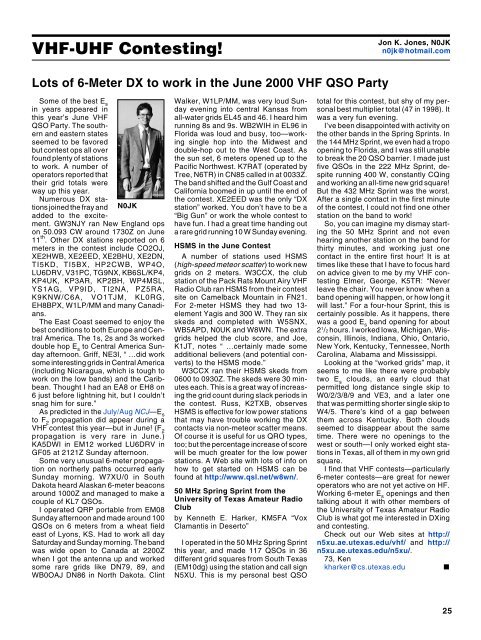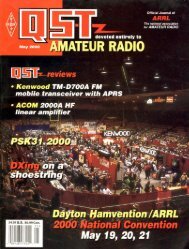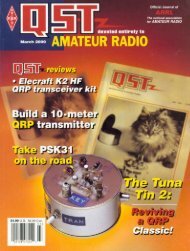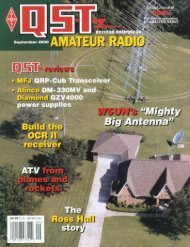September/October 2000 NCJ
September/October 2000 NCJ
September/October 2000 NCJ
Create successful ePaper yourself
Turn your PDF publications into a flip-book with our unique Google optimized e-Paper software.
VHF-UHF Contesting!Jon K. Jones, N0JKn0jk@hotmail.comLots of 6-Meter DX to work in the June <strong>2000</strong> VHF QSO PartySome of the best E sin years appeared inthis year’s June VHFQSO Party. The southernand eastern statesseemed to be favoredbut contest ops all overfound plenty of stationsto work. A number ofoperators reported thattheir grid totals wereway up this year.Numerous DX stationsjoined the fray and N0JKadded to the excitement.GW3NJY ran New England opson 50.093 CW around 1730Z on June11 th . Other DX stations reported on 6meters in the contest include CO2OJ,XE2HWB, XE2EED, XE2BHU, XE2DN,TI5KD, TI5BX, HP2CWB, WP4O,LU6DRV, V31PC, TG9NX, KB6SL/KP4,KP4UK, KP3AR, KP2BH, WP4MSL,YS1AG, VP9ID, TI2NA, PZ5RA,K9KNW/C6A, VO1TJM, KL0RG,EH8BPX, W1LP/MM and many Canadians.The East Coast seemed to enjoy thebest conditions to both Europe and CentralAmerica. The 1s, 2s and 3s workeddouble hop E sto Central America Sundayafternoon. Griff, NE3I, “ …did worksome interesting grids in Central America(including Nicaragua, which is tough towork on the low bands) and the Caribbean.Thought I had an EA8 or EH8 on6 just before lightning hit, but I couldn’tsnag him for sure.”As predicted in the July/Aug <strong>NCJ</strong>—E sto F 2propagation did appear during aVHF contest this year—but in June! (F 2propagation is very rare in June.)KA5DWI in EM12 worked LU6DRV inGF05 at 2121Z Sunday afternoon.Some very unusual 6-meter propagationon northerly paths occurred earlySunday morning. W7XU/0 in SouthDakota heard Alaskan 6-meter beaconsaround 1000Z and managed to make acouple of KL7 QSOs.I operated QRP portable from EM08Sunday afternoon and made around 100QSOs on 6 meters from a wheat fieldeast of Lyons, KS. Had to work all daySaturday and Sunday morning. The bandwas wide open to Canada at 2200Zwhen I got the antenna up and workedsome rare grids like DN79, 89, andWB0OAJ DN86 in North Dakota. ClintWalker, W1LP/MM, was very loud Sundayevening into central Kansas fromall-water grids EL45 and 46. I heard himrunning 8s and 9s. WB2WIH in EL96 inFlorida was loud and busy, too—workingsingle hop into the Midwest anddouble-hop out to the West Coast. Asthe sun set, 6 meters opened up to thePacific Northwest. K7RAT (operated byTree, N6TR) in CN85 called in at 0033Z.The band shifted and the Gulf Coast andCalifornia boomed in up until the end ofthe contest. XE2EED was the only “DXstation” worked. You don’t have to be a“Big Gun” or work the whole contest tohave fun. I had a great time handing outa rare grid running 10 W Sunday evening.HSMS in the June ContestA number of stations used HSMS(high-speed meteor scatter) to work newgrids on 2 meters. W3CCX, the clubstation of the Pack Rats Mount Airy VHFRadio Club ran HSMS from their contestsite on Camelback Mountain in FN21.For 2-meter HSMS they had two 13-element Yagis and 300 W. They ran sixskeds and completed with W5SNX,WB5APD, N0UK and W8WN. The extragrids helped the club score, and Joe,K1JT, notes “ …certainly made someadditional believers (and potential converts)to the HSMS mode.”W3CCX ran their HSMS skeds from0600 to 0930Z. The skeds were 30 minuteseach. This is a great way of increasingthe grid count during slack periods inthe contest. Russ, K2TXB, observesHSMS is effective for low power stationsthat may have trouble working the DXcontacts via non-meteor scatter means.Of course it is useful for us QRO types,too; but the percentage increase of scorewill be much greater for the low powerstations. A Web site with lots of info onhow to get started on HSMS can befound at http://www.qsl.net/w8wn/.50 MHz Spring Sprint from theUniversity of Texas Amateur RadioClubby Kenneth E. Harker, KM5FA “VoxClamantis in Deserto”I operated in the 50 MHz Spring Sprintthis year, and made 117 QSOs in 36different grid squares from South Texas(EM10dg) using the station and call signN5XU. This is my personal best QSOtotal for this contest, but shy of my personalbest multiplier total (47 in 1998). Itwas a very fun evening.I’ve been disappointed with activity onthe other bands in the Spring Sprints. Inthe 144 MHz Sprint, we even had a tropoopening to Florida, and I was still unableto break the 20 QSO barrier. I made justfive QSOs in the 222 MHz Sprint, despiterunning 400 W, constantly CQingand working an all-time new grid square!But the 432 MHz Sprint was the worst.After a single contact in the first minuteof the contest, I could not find one otherstation on the band to work!So, you can imagine my dismay startingthe 50 MHz Sprint and not evenhearing another station on the band forthirty minutes, and working just onecontact in the entire first hour! It is attimes like these that I have to focus hardon advice given to me by my VHF contestingElmer, George, K5TR: “Neverleave the chair. You never know when aband opening will happen, or how long itwill last.” For a four-hour Sprint, this iscertainly possible. As it happens, therewas a good E sband opening for about2 1 /2 hours. I worked Iowa, Michigan, Wisconsin,Illinois, Indiana, Ohio, Ontario,New York, Kentucky, Tennessee, NorthCarolina, Alabama and Mississippi.Looking at the “worked grids” map, itseems to me like there were probablytwo E sclouds, an early cloud thatpermitted long distance single skip toW0/2/3/8/9 and VE3, and a later onethat was permitting shorter single skip toW4/5. There’s kind of a gap betweenthem across Kentucky. Both cloudsseemed to disappear about the sametime. There were no openings to thewest or south—I only worked eight stationsin Texas, all of them in my own gridsquare.I find that VHF contests—particularly6-meter contests—are great for neweroperators who are not yet active on HF.Working 6-meter E sopenings and thentalking about it with other members ofthe University of Texas Amateur RadioClub is what got me interested in DXingand contesting.Check out our Web sites at http://n5xu.ae.utexas.edu/vhf/ and http://n5xu.ae.utexas.edu/n5xu/.73, Kenkharker@cs.utexas.edu■25
















